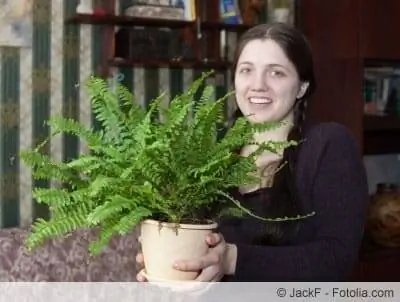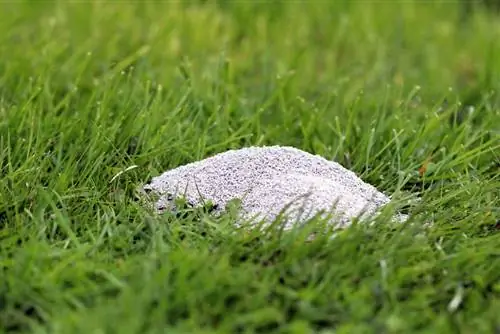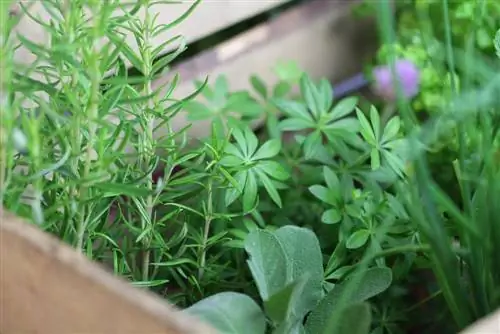- Author admin [email protected].
- Public 2023-12-17 03:39.
- Last modified 2025-06-01 06:48.
Ferns - whether as houseplants or outdoor specimens - look particularly attractive when they grow strong and lush. Unfortunately, this doesn't work without regular fertilizer application during the growth phase. Fern plants need the additional nutrients in order to become more resilient and to be able to grow. Ambitious gardeners do not necessarily have to use special fertilizers. Sometimes even small household remedies such as coffee grounds, fingernails or milk can help to strengthen the plant and stimulate it to grow.
Main components of fertilizers
In addition to light, water and carbon dioxide, plants especially need nutrients. The main nutrients are phosphorus, potassium, nitrogen and magnesium.
Nitrogen (N)
- ensures growth in root tips, more shoots and leaves
- is absorbed from the soil primarily as nitrate and to a small extent as ammonium
- Reception generally via roots
Phosphorus (P)
- essential for chlorophyll formation
- ensures strong roots
- promotes leaf development
Potassium (K)
- Stimulates plant metabolism
- ensures strong cell walls
- promotes resilience
- regulates water balance
Magnesium
- helps with photosythesis
- ensures lush green fern fronds and growth of the ferns
Differences in fertilization

Ferns have humus roots and are therefore sensitive to s alt. For this reason, the concentration of fertilizer must not be too high. For commercial fertilizer, a fertilizer concentration of 50 percent of the manufacturer's specifications is completely sufficient.
The frequency at which you should fertilize depends primarily on the substrate. Planted as a container plant in peat soil, the fern needs fertilizer every 14 days. If the fern is grown in compost soil, it is sufficient to fertilize it once a month. If the fern continues to grow weakly in the winter months, plant lovers fertilize their protégé at greater intervals. If the fern is hibernating, it is not fertilized at all.
After applying fertilizer, the substrate must not dry out. The soil should be moderately moist for a few days. This is the only way the nutrients can be absorbed by the roots.
Does long-term fertilizer make sense?
Long-term fertilizer is available in the form of organic fertilizer mixtures such as horn shavings, bone meal or blood meal and can be mixed into the soil when repotting. Because these organic fertilizers only decompose slowly in the soil, there is no high concentration of s alt at the roots of the ferns. This decomposition process is called mineralization and provides the fern plants with sufficient nutrients over a longer period of time. However, hobby gardeners should avoid adding additional fertilizer after using a slow-release fertilizer.
Suitable home remedies - natural fertilizers
If you don't want to use chemical fertilizers, you can fertilize and strengthen your plants with conventional household products. A wide variety of materials are suitable here, which can either be collected or made yourself.
Black Tea
Tea lovers don't have to throw away their used tea bags. These are ideal as a natural fertilizer for ferns. Tea bags can be easily collected in a closed container.
- simply brew again if necessary
- let cool to room temperature
- Water fern two to three times a month with the broth
- makes the leaves shine and ensures rich color

Tea leaves and tea grounds can also be used for fertilization. But mainly with ferns in the garden. Regardless of the variety (chamomile, nettle, black tea, herbal tea), tea grounds or tea leaves are lightly raked into the ground.
Milk
Ilch doesn't just make tired men cheer up again. Plant lovers also do something good for the fern with milk. The roots absorb the amino acids in the milk and as a result ferns thrive.
- Use homogenized, low-fat milk
- Mixing ratio - one part milk and three parts water or
- Dilute the remaining milk from the bag with water
- do not water over leaves, otherwise stains will occur
- fertilize with milk once or twice a month
Coffee grounds
Why throw away the coffee grounds? This also offers a successful alternative to commercial fertilizer and is also easy on the wallet. Coffee grounds are actually high-quality fertilizer that is just as suitable for indoor ferns as they are for outdoor specimens. It is rich in nitrogen, potassium and phosphorus. It also neutralizes hard water and keeps many pests away.
- Dispose of pads and filter bags as usual
- allow to cool before use
- apply dry to avoid mold formation
- do not fertilize with coffee grounds too often
Coffee grounds can also be diluted with plenty of water and used as irrigation water. Don't water the leaves, just the trunk.
Tip:
If you collect your coffee grounds over a certain period of time, you can mix them with the fresh soil as a long-term fertilizer when repotting and plant the fern in it.
Egg water
If breakfast eggs are classically boiled in water, the result is excellent watering water for ferns. In addition to oxygen and carbon, the shells also release valuable calcium, which is ideal as fertilizer.
Finger and toenails
It sounds strange at first, but it makes perfect sense. Grated hooves and horns from slaughtered cattle as a nitrogen-rich fertilizer are probably known to everyone as horn meal or horn shavings. So why not use cut human fingernails and toenails as fertilizer? For aesthetic reasons, however, they should be undermined a little.
Potato water
- contains many trace elements and minerals
- stimulates plants to grow
- cool and water the ferns with it once a week
Beer

Beer has a number of valuable nutrients. If you find one or two open bottles from your last party, you shouldn't throw away the barley juice carelessly. Simply pour the stale beer into the watering can and water the fern once or twice a month.
Strengthen
In addition to conventional home remedies, there are also products that not only fertilize plants but also strengthen them.
Plant manure
Such a remedy is plant manure. This can easily be made yourself from dandelion, horsetail, gourd, chamomile, garlic, onion and, above all, nettle:
- Vessel made of plastic, wood or stone
- Collecting and chopping plants
- Add rainwater
- Mixing ratio 1:10 (one kilogram of plant residues to ten liters of water)
- Place in a sunny place and cover with grid
- Stir manure once a day
- Odors are eliminated by adding stone powder
- Fermentation complete when no more bubbles form
- can be used diluted or pure
Frequently asked questions
My indoor fern has been looking weak and a bit puny for some time now. What can I do about it?
As described above, it is sufficient if the fern is regularly watered with a mixture of milk and water. He usually recovers quickly.
How often can ferns be fertilized with coffee grounds?
If the fern is outdoors, it is sufficient to fertilize it with coffee grounds up to four times a year. Indoor ferns, on the other hand, should only be supplied with this high-quality fertilizer once in winter and once in spring.
Watering and fertilizing quick tips
- Most ferns do not like drought. They should be watered regularly, but not submerged.
- The soil should never dry out!
- Ferns also like high humidity, so spray them every now and then!
- Do not use hard water!
- A good fertilizer for ferns is Oscorna Animalin.
- Do not use mineral fertilizers!
- Fertilize potted plants with organic liquid fertilizer!






